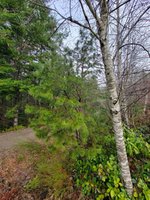TacomaBonsai95
Mame
Hey everyone,
I don't know if this is the right place to discuss this topic but, in my area (South Puget Sound) I always run into trees that seem to display characteristics of both western white pine and lodgpole pines. Is it possible for hybridization to occur in the wild? I included a picture of one of the trees, i will go back and take a closer picture. In these pics you can kinda see the way the needles droop like on a five needle pine.

I don't know if this is the right place to discuss this topic but, in my area (South Puget Sound) I always run into trees that seem to display characteristics of both western white pine and lodgpole pines. Is it possible for hybridization to occur in the wild? I included a picture of one of the trees, i will go back and take a closer picture. In these pics you can kinda see the way the needles droop like on a five needle pine.


